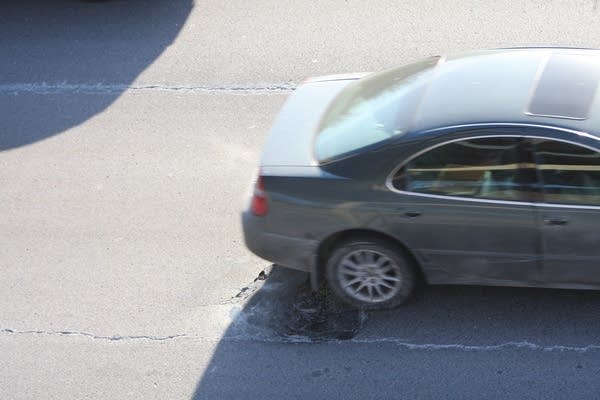Fixing bridges not Minnesota's only transportation problem
Go Deeper.
Create an account or log in to save stories.
Like this?
Thanks for liking this story! We have added it to a list of your favorite stories.

St. Cloud resident Dan Dillman, a veteran road warrior, sees the problem every weekday.
Monday through Friday the computer technician points his Toyota down the road toward his job in Elk River and does battle with U.S. Highway 10. The original U. S. Route 10, as it was called, was built in the late 1920s with portions in Minnesota built later at various times including as early as l947.
Major stretches have been refurbished since then and more improvements are in the works. However, Minnesota Department of Transportation officials say parts of the original roadway are still in use.
Dan Dillman says they are getting rough.
Turn Up Your Support
MPR News helps you turn down the noise and build shared understanding. Turn up your support for this public resource and keep trusted journalism accessible to all.
"The joints between the sections they make your car go cathunka, cathunka, cathunka all the way down the highway," he says.
The sound Dillman describes can be created on another aging stretch of Minnesota roadway, the 39-year-old Interstate 94 between St. Paul and Minneapolis.
Measured in human terms 39 should be the best years -- the prime of life.
Not the case for highways, including I-94, according to the Minnesota Department of Transportation's pavement engineer, Curt Turgeon.
"The original pavement there has gone far beyond its original intended service life," he says.

Every year Turgeon and his colleagues measure the condition of the 14,000 miles of roadway maintained by MnDOT. Turgeon says 70 percent of the miles on the most heavily traveled routes in Minnesota are in decent condition.
However, he says, on those same heavily traveled routes the percent of road surface that is worn out, about 3 percent, is steadily increasing.
"We are seeing an increase in the number of miles in those bad categories," he says.
On the stretch of I-94 between Minneapolis and St. Paul, Turgeon says the remedy for the worn out concrete underneath is a four inch layer of asphalt every eight years.
Some sections toward Minneapolis are brand new asphalt, others are 6-years-old. The stretch of asphalt overlay on I-94 from Snelling Avenue to downtown St. Paul is 14-years-old.
There are plate and platter sized chunks of asphalt missing. Vertical and horizontal seems are splitting and big gaps are forming. Weather, especially winter weather with freezing and thawing hastens the damage.
Traffic volume is also a road killer.
Transportation experts assert and Turgeon agrees that on heavily traveled roads trucks account for most of the damage.
The reason the percent of Minnesota roads in the most dire shape is increasing is no surprise to anyone, Turgeon says.
"To be honest we have less real dollars to spend than we have had in the past," he says.
That is the story everywhere in Minnesota.
Inflation is up, fueled in large measure by rising prices for crude oil, a main ingredient in road repair asphalt.
In Hennepin County for example the people who patch potholes are having to cut back. Hennepin County had hoped last year to patch and repair 100 miles of Hennepin County roadway, says Ia Xiong who helps manage road and bridge repair in the county.
"Due to the oil price increase we were only able to do about 75 lane miles so it's been reduced about 25 percent," she says.
MnDOT's Curt Turgeon says it will be at least a year before crews redo the asphalt overlay on I-94 between St. Paul and Minneapolis.
"[We'll] probably do it in '09 and potentially do it seven or eight years after that, and at that point people are starting to think that, you know, you can only patch this thing so many times before we really have to bite the bullet and go in there and do it right."
Doing it right means a complete rebuild, tearing up the old concrete roadbed, putting in new infrastructure, ramps, everything, says Turgeon. But there is no plan and no money on the horizon for a project of that scale.
Dan Dillman from St. Cloud says the solution is obvious: Find the money to fix the roads.
But the obvious source, a user fee, namely increasing the gas tax five or 10 cents per gallon causes Dillman consternation.
"Boy you know that hurts. For somebody that's gotta commute everyday and spends $50 to $60 a week in gas, and I've got a small Toyota, raising that at all is going to be a hardship," he says. "Maybe I could afford 10 cents but I wouldn't want to push it any higher than that. The problem with that is gas prices aren't going to stay where they're at. They're going up, too."
Exactly.
It is the very issue that has foiled attempts by lawmakers and the governor the past few years to agree on a transportation funding strategy. They face it again as they prepare to lock horns over transportation spending when the next legislative session convenes in February.



